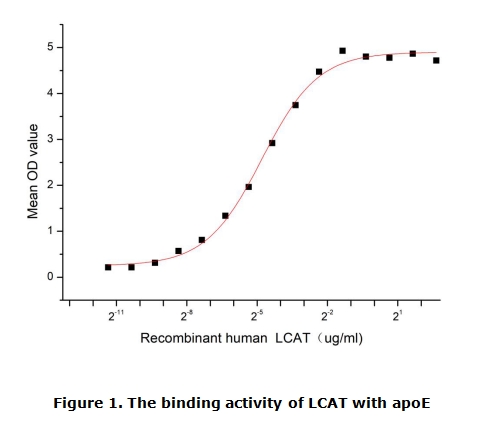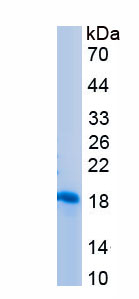Active Lecithin Cholesterol Acyltransferase (LCAT) 

phosphatidylcholine-sterol O-acyltransferase; Phospholipid-cholesterol acyltransferase
- UOM
- FOB US$ 312.00 US$ 780.00 US$ 1,560.00 US$ 4,680.00 US$ 11,700.00
- Quantity
Overview
Properties
- Product No.APJ516Hu01
- Organism SpeciesHomo sapiens (Human) Same name, Different species.
- ApplicationsCell culture; Activity Assays.
Research use only - DownloadInstruction Manual
- CategoryEnzyme & Kinase
- Buffer FormulationPBS, pH7.4, containing 0.01% SKL, 5% Trehalose.
- Traits Freeze-dried powder, Purity > 90%
- Isoelectric Point5.8
Sign into your account
Share a new citation as an author
Upload your experimental result
Review

Contact us
Please fill in the blank.
Activity test

LCAT(Phosphatidylcholine-sterol acyltransferase) is an enzyme in the extracellular metabolism of plasma lipoproteins, which converts cholesterol and phosphatidylcholines(lecithins) to cholesteryl esters and lysophosphatidylcholines. It is reported that Apolipoprotein E (apoE) is the main LCAT activator in glia- conditioned media (GCM). Thus, a binding ELISA assay was conducted to detect the association of recombinant human LCAT with recombinant human apoE. Briefly, recombinant human LCAT were diluted serially in PBS with 0.01% BSA(pH 7.4). Duplicate samples of 100ul were then transferred to apoE-coated microtiter wells and incubated for 2h at 37°C. Wells were washed with PBST and incubated for 1 h with anti-LCAT pAb, then aspirated and washed 3 times. After incubation with HRP labelled secondary antibody, wells were aspirated and washed 3 times. With the addition of substrate solution, wells were incubated 15-25 minutes at 37°C. Finally, add 50µL stop solution to the wells and read at 450nm immediately. The binding activity of LCAT with apoE was shown in Figure 1 ,the EC50 for this effect is 0.036ug/mL.
Usage
Reconstitute in 10mM PBS (pH7.4) to a concentration of 0.1-1.0 mg/mL. Do not vortex.
Storage
Avoid repeated freeze/thaw cycles. Store at 2-8°C for one month. Aliquot and store at -80°C for 12 months.
Stability
The thermal stability is described by the loss rate. The loss rate was determined by accelerated thermal degradation test, that is, incubate the protein at 37°C for 48h, and no obvious degradation and precipitation were observed. The loss rate is less than 5% within the expiration date under appropriate storage condition.
Increment services
-
 BCA Protein Quantification Kit
BCA Protein Quantification Kit
-
 Molecular Mass Marker for Protein
Molecular Mass Marker for Protein
-
 Monoclonal Antibody Customized Service
Monoclonal Antibody Customized Service
-
 Polyclonal Antibody Customized Service
Polyclonal Antibody Customized Service
-
 Protein Activity Test Experiment Service
Protein Activity Test Experiment Service
-
 Electrophoretic Mobility Shift Assay (EMSA) Experiment Service
Electrophoretic Mobility Shift Assay (EMSA) Experiment Service
-
 Buffer
Buffer
-
 Lentivirus Packaging Experiment Service
Lentivirus Packaging Experiment Service
-
 Adenovirus Packaging Experiment Service
Adenovirus Packaging Experiment Service
-
 Real Time PCR Experimental Service
Real Time PCR Experimental Service
-
 Spike RBD Protein (S-RBD)
Spike RBD Protein (S-RBD)
-
 Protein G
Protein G
-
 Protein A
Protein A
Citations
- Plasma phospholipase, γ‐CEHC and antioxidant capacity in fibromyalgiaPubMed: 26585319
- Alteration of Lysophosphatidylcholine-Related Metabolic Parameters in the Plasma of Mice withExperimental Sepsis.pubmed:28028754
- A combined biomarker panel shows improved sensitivity for the early detection of ovarian cancer allowing the identification of the most aggressive type II tumours.pubmed:28664912
- Lipid-lowering effects of medium-chain triglyceride-enriched coconut oil in combination with licorice extracts in experimental hyperlipidemic micePubmed: 30244576
- Identification and validation of differentially expressed proteins in serum of CSU patients with different duration of wheals using an iTRAQ labeling, 2D‑LC‑MS/MSDoi: 10.3892/etm.2018.6818
- Diagnosis of epithelial ovarian cancer using a combined protein biomarker panel.Pubmed: 31388184
- The synergistic mechanism of total saponins and flavonoids in Notoginseng− Safflower pair against myocardial ischemia uncovered by an integrated …Pubmed: 32739736
- Pharmacokinetics/pharmacometabolomics-pharmacodynamics reveals the synergistic mechanism of a multicomponent herbal formula, Baoyuan decoction?¡
- Defects in a liver-bone axis contribute to hepatic osteodystrophy disease progressionPubmed:35235775







